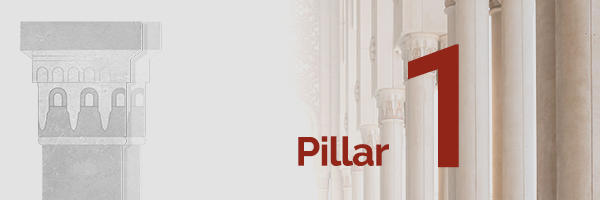- Vision
To be a globally influential and locally impactful university where lifelong learners, engaged scholars and community leaders collaborate to advance innovation and excellence in education, research and creative work.
- Mission
To harmonize an American educational model with Sharjah’s heritage and culture by advancing knowledge, fostering innovation and preparing AUSers to lead with purpose, competence and open dialogue.
- Values
Our values are more than guiding principles–they are who we are. Together, they form AUSer, a reflection of the spirit and aspirations that unite our community:
- Achievement: Striving for excellence in all we do.
- Understanding: Embracing diversity of people, perspectives and ideas.
- Service: Empowering individuals and communities through action.
- Entrepreneurship: Fueling innovation and initiative.
- Responsibility: Acting with integrity, ethics and a commitment to sustainability.
Strategic Planning Process
We see strategy as a living process that connects our ambition with action and ensures that every step forward is grounded in evidence and community input. The development of the AUS 2025–2030 Strategic Plan was a collective effort, shaped through a rigorous three-phase journey: Assess, Strategize and Plan.
Phase One: Assess
We began by conducting a comprehensive review of our current position. This meant reviewing past achievements, identifying current priorities and listening closely to the voices of our community through surveys and focus groups. We benchmarked AUS against leading universities locally, regionally and globally, producing a comprehensive “Current State Assessment” that highlighted both our strengths and our opportunities for growth. This analysis was presented to our Board of Trustees in October 2024 as the foundation for what was to come.
Phase Two: Strategize
With this groundwork in place, we turned toward the future. Through workshops with AUS leadership, we refined our vision, mission and values, and identified the strategic pillars that now anchor this plan. Each proposed initiative was carefully assessed for impact and feasibility, ensuring alignment with our long-term goals. To maintain accountability, we created a framework for monitoring progress through clear, measurable KPIs. This framework was endorsed by AUS’ President and Board Chair in February 2025.
Phase Three: Plan
The final phase focused on translating our vision into action. Detailed roadmaps were developed for each initiative, with clear milestones, timelines and resources. We also built a process that links strategic priorities directly with annual budgets, ensuring that this plan is not only ambitious, but also achievable. Throughout every stage, AUS leadership and stakeholders remained deeply engaged, ensuring transparency, alignment and community buy-in.
This process was about charting a course for the future together. It reflects our commitment to evidence-based decisions, our dedication to excellence and our determination to shape the next chapter of AUS with clarity and purpose.
Strategic Pillars
Our strategy is built on five pillars that will guide AUS into the future. Together, they strengthen our academic excellence, expand our research and creative impact, empower our people, extend our partnerships and ensure that we steward our resources responsibly and sustainably.
- Pillar 1. A Transformative Educational Experience
We are enhancing the academic journey at AUS, making it even more rigorous, relevant and future-focused.
- For undergraduate students: cutting-edge curricula, inclusive student life and flexible, technology-enhanced learning will prepare them for a world shaped by digital transformation and social change.
- For graduate education: expanded programs and residential offerings will nurture a research-intensive environment that attracts top-tier scholars.
By investing in both undergraduate and graduate experiences, AUS affirms its position as the first-choice destination for ambitious students, outstanding faculty and global partners.
- Pillar 2. Growing the Impact of Our Research and Creative Work
AUS is advancing knowledge that speaks to the world.
- We are building a culture of interdisciplinary discovery, supported by strategic investment in people, infrastructure and partnerships.
- Our faculty and students will be empowered to produce work that drives innovation, shapes policy, addresses global challenges and enriches society.
This pillar positions AUS as a forward-looking producer of research and creative work defined by rigor, influence and relevance.
- Pillar 3. An Empowering Working Culture
Our people are our strength.
- AUS will cultivate an environment where faculty and staff thrive through balanced workloads, streamlined operations and continuous professional growth.
- Diversity, equity and inclusion will underpin everything we do, ensuring a workplace that empowers excellence.
By valuing collaboration, wellbeing and innovation, AUS will be known as a place where talent flourishes and ideas thrive.
- Pillar 4. Leveraging Community Engagement and Outreach
AUS will expand its influence across academia, industry and society.
- By strengthening partnerships, mobilizing our global alumni and advancing international recruitment, we will amplify our reach and reputation.
- Our commitment to sustainability will guide how we collaborate with communities and contribute to positive change.
Through these efforts, AUS will remain a destination of choice for talent, investment and meaningful partnerships.
- Pillar 5. Effective Stewardship of Our Resources
Great institutions are defined by how they manage themselves and their legacy.
- AUS will pursue operational excellence, fiscal discipline and environmental responsibility.
- Through digital transformation, sustainable planning and careful stewardship, we will ensure resilience and agility.
This pillar safeguards AUS’ future while fueling our evolution into a premier global institution prepared for transformative change.
Strategic Objectives
Our vision will be brought to life through ten strategic objectives aligned with our five pillars. These objectives translate ambition into action, ensuring that every member of the AUS community sees progress and impact.
Pillar 1. A Transformative Educational Experience
Objective 1: Enhance teaching, learning and academic support by updating curricula, enriching student life and introducing flexible, inclusive learning models.
Objective 2: Expand graduate education to establish AUS as a globally recognized research institution, with new academic and residential opportunities that attract top scholars.
Pillar 2. Growing the Impact of Our Research and Creative Work
Objective 3: Advance high-quality, interdisciplinary research and creative work that addresses pressing local and global challenges.
Objective 4: Translate research into real-world solutions by strengthening innovation, entrepreneurship and research support systems.
Pillar 3. An Empowering Working Culture
Objective 5: Support faculty by redefining workloads, streamlining processes and enabling stronger integration of teaching and research.
Objective 6: Create a culture of empowerment for employees through professional development, clear pathways for growth and rewarding working conditions.
Pillar 4. Leveraging Community Engagement and Outreach
Objective 7: Grow AUS’ international profile by expanding recruitment, mobilizing our alumni and strengthening our global reputation.
Objective 8: Diversify and optimize revenue streams through partnerships, commercialization opportunities and innovative fundraising.
Pillar 5. Effective Stewardship of Our Resources
Objective 9: Safeguard AUS’ core mission through disciplined financial management, sustainability and operational excellence.
Objective 10: Transform operations and governance with digital infrastructure that fosters agility, accountability and efficiency.
Measuring Success
- Our Strategic Key Performance Indicators (KPIs) over the next five years:
Pillar 1: A Transformative Educational Experience
1. First-year undergraduate retention rate
2. Six-year undergraduate graduation rate
3. (i) Number of doctoral degrees awarded annually, (ii) with the median time-to-degree (TTD) for completers less than or equal to four years
4. Percentage of graduates employed or pursuing further education within nine months of graduation
5. Undergraduate to graduate student ratio
6. Composite student satisfaction rate
Pillar 2: Growing the Impact of our Research and Creative Work
7. (i) Total research spending per faculty/researcher FTE and (ii) proportion of research
expenditures from external sources
8. (i) Percentage of papers in top 10 percent journals; (ii) percentage of books and book chapters with top publishers; (iii) number of juried creative works presented, exhibited or performed in venues of significance
9. Median Field-Weighted Citation Impact (FWCI) score (five years)
10. Percentage of (i) published research and (ii) creative works with international collaboration
11. Innovation and entrepreneurship output: (i) number of patents filed; (ii) number of startups
12. Percentage of students engaged in research
Pillar 3: An Empowering Working Culture
13. Median teaching load (credits/course sections per academic year) for rolling-contract faculty with a professorial rank
14. Student-to-faculty ratio
15. Employee satisfaction and engagement
Pillar 4: Leveraging Community Engagement and Outreach
16. Percentage of total institutional revenues generated from non-tuition and non-government sources (e.g., institutional grants, research grants, externally sponsored scholarships, consulting, executive education, endowment contributions, commercialization, AUSE)
17. Percent increase in funds raised through alumni and partner contributions
18. Total endowment
19. International academic mobility (based on the percentage of students who participate in an
international academic experience and the percentage of faculty involved in international academic activities during the academic year)
20. Number of learners served through executive and continuing education programs annually
21. Brand awareness in target markets
Pillar 5: Effective Stewardship of our Resources
22. Operating margin
23. Student financial support (merit and need-based) as a percentage of institutional operating budget
24. Discount rate
25. Average turnaround time efficiency for core administrative processes (HR, Finance, IT and Procurement processes)
26. Percentage of operational KPI targets achieved across AUS strategic initiatives.
Monitoring and Evaluation
A strategy is only as strong as its execution. We are committed to turning ambition into measurable progress through a transparent, data-driven system that keeps us focused, agile and accountable.
At the center of this effort is a unified digital platform that tracks every facet of the strategic plan—our pillars, objectives, initiatives and milestones—in one place. This allows us to monitor progress in real time, ensure alignment across the university and provide a clear line of sight from daily actions to long-term goals.
Roles and Responsibilities
- Board of Trustees: Provides oversight and governance.
- Executive Leadership: Monitors performance and drives responsiveness.
- Pillar Leads: Ensure execution and maintain data integrity.
- Strategy Office: Coordinates systems, reporting and review cycles.












